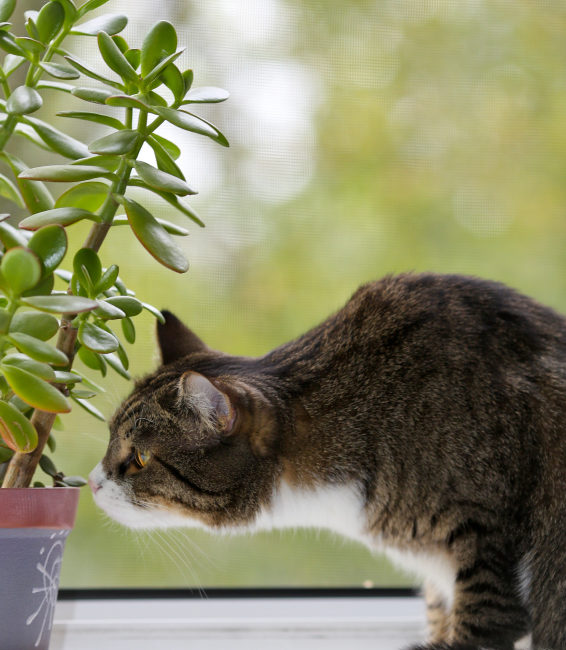Cats are beautiful creatures! Smart, entertaining, even majestic. Cats are also creatures of habit who DIS-like change. Cats are notorious for being stoic; putting on a brave front but in reality may not be coping so well. Some cats never appear to be affected by change and seem to have that go with the flow temperament. For many others any change that affects them physically or mentally (environmental change) can create more havoc and upset than a Category 5 Hurricane! Number 1 sign that something is amiss with Fluffy is inappropriate urination outside of the litter box. This is often not detected until after a long period of time when you suddenly discover that the storage box in the basement or that hidden corner in the living room has been his personal litter box for quite some time. Sometimes less subtle signs are decreased appetite, decreased litter box activity, withdrawal, failure to enjoy the things he once seemed to live for.
It’s important to try to keep things as routine as possible for your cat.
Here are some tips to help make life more peaceful for Fluffy:
When moving into a new house
- Introduce your cat to the house slowly. Start with confinement to 1 room first with food, litter box etc. This will give your cat time to adjust to the new sounds and smells. This will also give Fluffy a place of comfort to retreat back to later on if he becomes too overwhelmed. As Fluffy settles in your can begin to SLOWLY allow access to the rest of the home.
- Surround Fluffy with things that smell familiar: blankets, articles of your clothing, toys etc. Make sure this space is safe with no open windows or crawl spaces.
- Allow Fluffy to explore on his own momentum. Many cats will choose to explore under the cover of darkness. Don’t force the issue. If he chooses to hide under the bed for 3 days that’s ok. He will eventually come out when he feels safe. Be sure to monitor eating and litter box activity. Urinary infections, bowel disturbances can be created by Fluffy “holding it in” because he’s too nervous to come out. You may need to intervene at this point.
- It is always advised to keep Fluffy indoors. However, if Fluffy is an outdoor kitty you might want to consider keeping him confined inside at least for a short period of time (2-4 weeks) until he can get familiar with his surroundings. If you do decide to let him out consider using a leash (never unsupervised!) and be sure to accompany him outside. Start with short visits outdoors about 10 mins and gradually increase the time you are outside with him every day until he feels safe and comfortable.
New addition to the home (pet, baby):
- Cats are solitary and territorial creatures. Even in the wild, the Lion is the ONLY cat that lives in groups. They do NOT adjust well to *intruders*. Cats CAN learn to share their living space with other pets/people but introduction must be done VERY slowly. If it’s is pushed too quickly you may be setting your pet and your family up for disaster and a lifetime of resentment and unease in the home. Never just toss the new pet in and take the “they’ll work it out!” approach. Your veterinary staff can easily offer information on how to make this transition smooth. Beware, some cats will NEVER adjust to a new addition to the home. You need to be prepared for this and have a plan in place in case the outcome isn’t what you expected.
- Never permit children/babies to enter into your cats’ personal space uninvited. If your cat wants to be petted he will come to them. Keep children/babies away from your pets’ food and water bowls. Never permit your child to crawl on your cat or pull his fur/tail etc. You may think it’s cute and all part of your childs’ learning process but trust me your cat does not and will quickly learn to resent the offender.
- Never allow your new dog/puppy to chase your cat. Always introduce a new dog to your cat while the dog is under control of a leash. And never allow your dog to invade your cat’s space. Let your cat approach the dog on HIS terms and momentum.
- If introducing a new cat be sure to also bring in additional food dishes and litter boxes. A good rule of thumb for litter boxes is 1 litter box per cat PLUS one. Every cat should have its’ own food/water dishes even though they may eat out of any or all of them. They should be encourage to use their own.
There are many products on the market that are geared towards helping your cat feel more at peace and settled in any situation whether it’s moving to a new home, moving the living room sofa to another location, bringing new pets or babies into the home, vacationing guests etc. These products emit pheromones that will comfort your cat. Many trials have been done on these products proving their efficiency. We have personally implemented the use of these products at our Riverview veterinary clinic with our patients in the kennel rooms and in the examination rooms, on items that are used with restraint like gloves & towels. We also use it to keep our own clinic cat, Holly who is incredibly skittish, nervous and unsettled by change to be more settled. This product has decreased her inappropriate elimination from almost 100% of the time just a few short years ago to 0%! There is also the pharmaceutical route with prescription medications that are available in harder to treat cases. The Mountain Road Animal Hospital team is ready to talk to you about your new situation for your cat. Let us know about any help you may need!



